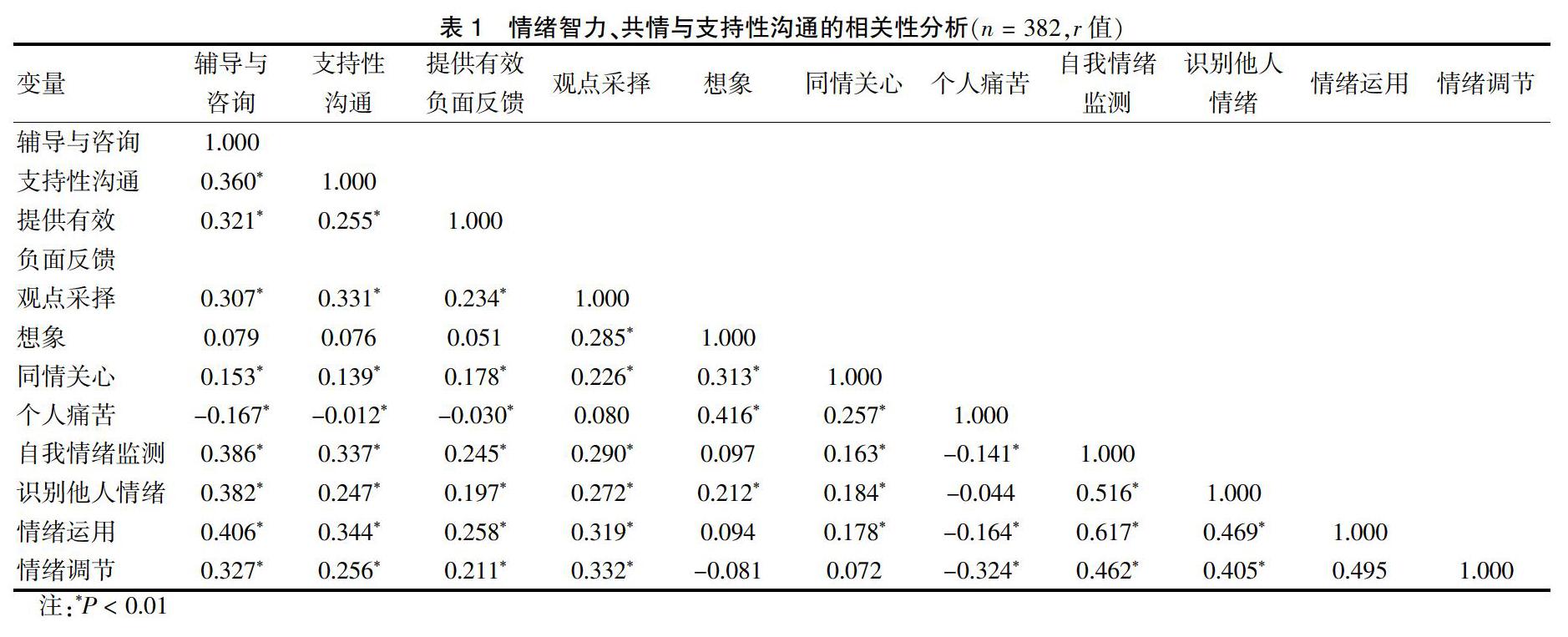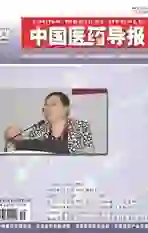临床专科护士情绪智力、共情与支持性沟通的现状与关系分析
2020-08-27郭洋村周利华王维利
郭洋村 周利华 王维利



[摘要] 目的 调查临床专科护士情绪智力、共情与支持性沟通的现状,并分析三者之间的关系。 方法 采用方便抽样法,选取2018年7~9月安徽医科大学第一附属医院及中国科学技术大学附属第一医院的临床专科护士410名为研究对象,运用一般资料问卷、情绪智力量表、人际反应指针问卷与支持性沟通量表进行调查。 结果 最终回收382份,有效回收率为93.2%。临床专科护士情绪智力、共情、支持性沟通总分分别为(82.63±11.76)、(46.00±9.13)、(70.64±5.64)分;观点采择、同情关心、自我情绪监测、情绪运用、情绪调节均与支持性沟通呈正相关(r = 0.331、0.139、0.337、0.344、0.256,P < 0.01);个人痛苦与支持性沟通呈负相关(r = -0.012,P < 0.01);共情在情绪智力与支持性沟通之间起部分中介作用。 结论 情绪智力与共情是临床专科护士支持性沟通的重要影响因素,管理者及临床专科护士应当注重提高护士的情绪智力与共情,使护士更加高效地为患者提供优质的护理。
[关键词] 临床专科护士;情绪智力;共情;支持性沟通
[中图分类号] R47-4 [文献标识码] A [文章编号] 1673-7210(2020)07(a)-0186-04
[Abstract] Objective To investigate the current situation of emotional intelligence, empathy and supportive communication among clinical nurses and analyze the relationship among them. Methods Convenience sampling was sued, from July to September 2018, 410 nurses from the First Affiliated Hospital of Anhui Medical University and the First Affiliated Hospital of University of Science and Technology of China were selected as the study subjects, general information questionnaire, emotional intelligence scale, interpersonal response indicator questionnaire and supportive communication scale were used to investigate. Results Finally, 382 copies were recovered with an effective recovery rate of 93.2%. The total scores of emotional intelligence, empathy and supportive communication were (82.63±11.76), (46.00±9.13) points and (70.64±5.64) points, respectively. Opinion selection, sympathy and care, self-emotional monitoring, emotional application and emotional regulation were positively correlated with supportive communication (r = 0.331, 0.139, 0.337, 0.344, 0.256, P < 0.01). Personal distress was negatively correlated with supportive communication (r = -0.012, P < 0.01). Empathy was a mediator between emotional intelligence and supportive communication. Conclusion Emotional intelligence and empathy are important factors influencing the supportive communication of clinical nurses. Managers and clinical nurses should pay attention to improving the emotional intelligence and empathy of nurses, so that nurses can provide quality care to patients more efficiently.
[Key words] Clinical specialized nurses; Emotional intelligence; Empathy; Supportive communication
臨床专科护士是指在临床护理领域中具有丰富的临床经验与知识,可直接提供高质量护理服务的护士[1-2]。临床专科护士不仅需要丰富的理论知识、娴熟的操作技能[3],也需要有较高水平的人际沟通能力[4]。支持性沟通有助于了解患者的身心状况,促进护患之间的理解与支持[5]。情绪智力是指个体适应性的知觉、理解、调节自己与他人的情绪以及利用情绪解决问题的能力[6-8]。共情是一种感情的投射,共情能力高的护士能够真诚地感知对方的情感和处境[9]。目前,关于临床专科护士情绪智力、共情与支持性沟通的研究较少。本研究旨在调查临床专科护士情绪智力、共情与支持性沟通的现状,分析三者之间的关系,从而为提高临床专科护士的支持性沟通能力提供相关参考。
1 对象与方法
1.1 研究对象
采取方便抽样法,选取2018年7~9月安徽医科大学第一附属医院及中国科学技术大学第一附属医院的临床专科护士410名进行问卷调查。纳入标准:①在职;②参加专科护士培训并取得资格证书;③省级水平以上专科护士;④知情同意。排除标准:①实习、进修人员;②调查期间因休假等不在岗者。
1.2 研究方法
1.2.1 调查工具 ①一般资料调查问卷:包括年龄、性别、专业技术职务、目前所在专科、从事目前所在专科的工龄等。②情绪智力量表(Wong&Law Emotional Intelligence Scale,WLEIS)[10]:该量表包括16个条目,采用Likert 7级计分法,从“完全不符合”到“完全符合”分别计1~7分。各维度得分总和为量表总分,总分16~102分,得分越高表示情绪智力水平越高。在本研究中的Cronbach′s α系数为0.895。③人际反应指针(IRI-C)问卷[11]:包括4个维度22个条目,采用自评方式,Likert 5级计分法,从“不恰当”到“非常恰当”,分别为0~4分。总分0~88分,得分越高表明个体共情水平越高。在本研究中的Cronbach′s α系数为0.724。④支持性沟通量表[12]:该量表包括3个维度20个条目,采用Likert 5级计分,完全不同意计1分,完全同意计5分,均为正向计分。总分20~100分,得分越高表明人际沟通能力越强。在本研究中的Cronbach′s α系数为0.665。
1.2.2 调查方法 研究者使用统一指导语,遵循知情同意原则。共发放问卷410份,回收394份,回收率为96.1%,其中有效问卷382份,有效回收率为93.2%。
1.3 统计学方法
采用SPSS 24.0软件对数据进行统计学分析。运用AMOS 24.0进行模型拟合,中介效应检验采用逐步回归和偏差校正的非参数百分位Bootstrap方法进行检验。计量资料以均数±标准差(x±s)表示,计数资料以例数表示。采用多元线性回归进行多因素统計分析。以P < 0.05为差异有统计学意义。
2 结果
2.1 临床专科护士情绪智力、共情与支持性沟通的现状
临床专科护士情绪智力总分为(82.63±11.76)分,共情总分为(46.00±9.13)分,支持性沟通总分为(70.64±5.64)分。
2.2 临床专科护士情绪智力、共情与支持性沟通的关系分析
2.2.1 情绪智力、共情与支持性沟通的相关性分析 观点采择、同情关心、自我情绪监测、情绪运用、情绪调节均与支持性沟通呈正相关(r = 0.331、0.139、0.337、0.344、0.256,P < 0.01);个人痛苦与支持性沟通呈负相关(r = -0.012,P < 0.01)。见表1。
2.2.2 情绪智力、共情对支持性沟通的回归分析 以支持性沟通为因变量,情绪智力与共情各维度作为自变量进行多元线性回归分析。见表2。
2.2.3 共情在情绪智力与支持性沟通之间的中介效应分析 本研究根据温忠麟等[13]提出的中介效应检验流程得出标准化回归方程:Y=21.706+0.435X+0.493M(Y:因变量;X自变量;M:中介变量)。系数a、b显著,进而检验系数c′,回归分析结果显示c′(0.435)达到显著水平。提示共情在临床专科护士情绪智力与支持性沟通中发挥部分中介效应作用。
2.2.4 中介效应的验证 采用极大似然法进行中介效应检验,结果显示:卡方自由度比值(λ2/df)=2.91,拟合优度指数(GFI)=0.875。见图1。结果显示,情绪智力到支持性沟通的间接效应成立(95%CI:0.05~0.24),且情绪智力到支持性沟通的直接效应成立(95%CI:0.03~0.25)。
3 讨论
3.1 临床专科护士情绪智力、共情与支持性沟通的现状分析
临床专科护士情绪智力总分为(82.63±11.76)分,提示临床专科护士总体情绪智力在中上水平,可能与护理工作中存在大量与情绪有关的劳动,迫使临床护士处理情绪问题的能力不断提高有关[14]。临床专科护士共情总分为(46.00±9.13)分,处于较低水平,在实际情境中,由于繁忙工作的限制[15],临床专科护士没有充分运用共情能力去识别和接纳患者的情绪与情感。临床专科护士支持性沟通总分为(70.64±5.64)分,处于中等水平,因此建议管理者对护理人员开展有针对性的培训。
3.2 临床专科护士情绪智力、共情和支持性沟通的关系分析
3.2.1 情绪智力、共情均与支持性沟通呈正相关 本研究结果显示,情绪智力与共情呈正相关(P < 0.05),较高的情绪智力水平可以为患者营造一个良好的康复氛围[16]。情绪智力与支持性沟通呈正相关(P < 0.05),护士具备良好情绪智力可以推动护患沟通的顺利进行[17]。共情与支持性沟通呈正相关(P < 0.01),即护士共情能力越高,就越能够了解支持性沟通的状态及变化,能够自然地站在患者的角度考虑问题。
3.2.2 共情在情绪智力与支持性沟通之间起部分中介作用 共情包括认知、情感及行为3个方面[18]。本研究显示,共情在临床专科护士情绪智力与支持性沟通之间起部分中介作用,可能是因为共情对支持性沟通有正向预测作用。护理人员通过具备共情的意识、表达共情、共情反馈等方式让患者感受到自己被理解,被尊重,从而增强护患沟通的效果[19]。护士需经常安慰患者及家属,帮助他们认识疾病,安抚其不良情绪,而这些工作需要发挥情绪智力作用[20]。因此,临床专科护士应重视共情能力的培养,进而有效改善护患关系。
4 小结
本研究構建了情绪智力、共情与支持性沟通3个变量间的关系模型,证实了共情在二者间的中介作用,提示临床专科护士可以采取换位思考,同情关心等措施提高自身的支持性沟通水平。
[参考文献]
[1] Scott RA. A description of the roles,activities,and skills of clinical nurse specialists in the United States [J]. Clin Nurse Spec,1999,13(4):183-190.
[2] Mayo AM,Ray MM,Chamblee TB,et al. The Advanced Practice Clinical Nurse Specialist [J]. Nurs Adm Q,2017, 41(1):70-76.
[3] Buckley L,Robertson S,Wilson T,et al. The Role of the Specialist Nurse in Gynaecological Cancer [J]. Curr Oncol Rep,2018,20(10):1-6.
[4] Salander P,Isaksson J,Granstr?觟m B,et al. Motives that head and neck cancer patients have for contacting a specialist nurse - an empirical study [J]. J Clin Nurs,2016(21/22):3160-3166.
[5] Jones SM. The Impact of Mindfulness on Supportive Communication Skills:Three Exploratory Studies [J]. Mindfulness,2015,6(5):1115-1128.
[6] Henry D. Emotional Intelligence [J]. Am J Nurs,2017,117(10):13-19.
[7] Chao M,Shih CT,Hsu SF. Nurse occupational burnout and patient-rated quality of care:The boundary conditions of emotional intelligence and demographic profiles [J]. Jpn J Nurs Sci,2016,13(1):156-165.
[8] Davies S,Jenkins E,Mabbett G. Emotional intelligence:district nurses′ lived experiences [J]. Br J Community Nurs,2010,15(3):141-146.
[9] Vacho DD,Lynam DR,Johnson JA. The(non)relation between empathy and aggression:surprising results from a meta-analysis [J]. Psychol Bull,2014,140(3):751-773.
[10] Extremera Pacheco N,Rey L,Sánchez-?譧lvarez N. Validation of the Spanish version of the Wong Law Emotional Intelligence Scale (WLEIS-S) [J]. Psicothema,2019,31(1):94-100.
[11] 安秀琴.杰弗逊共情量表(JSE-HP)在护士中的应用研究[D].太原:山西医科大学,2008.
[12] 袁秋环.护生评判性思维能力及其与人际沟通能力、自我效能感的相关性[D].青岛:山东大学,2008.
[13] 温忠麟,叶宝娟.中介效应分析:方法和模型发展[J].心理科学进展,2014,22(5):731-745.
[14] Kaur D,Sambasivan M,Kumar N. Impact of emotional intelligence and spiritual intelligence onthe caring behavior of nurses:a dimensionlevel exploratory study among public hospitals in Malaysia [J]. Appl Nurs Res,2015,28(4):293-298.
[15] Allenbaugh J,Corbelli J,Rack L,et al. A Brief Communication Curriculum Improves Resident and Nurse Communication Skills and Patient Satisfaction [J]. J Gen Intern Med,2019,34(7):1-7.
[16] Bledow R,Schmitt A,Frese M,et al. The affective shift model of work engagement [J]. J Appl Psychol,2011,96(6):1246-1257.
[17] Cunico L,Sartori R,Marognolli O,et al. Developing empathy in nursing students:a cohort longitudinal study [J]. J Clin Nurs,2012,21(13/14):2016-2025.
[18] Burridge LH,Winch S,Kay M,et al. Building compassion literacy:Enabling care in primary health care nursing [J]. Collegian,2017,24(1):85-91.
[19] Taleghani F,Ashouri E,Saburi M. Empathy,Burnout,Demographic Variables and their Relationships in Oncology Nurses [J]. Iran J Nurs Midwifery Res,2017,22(1):41-45.
[20] Haramati A,Cotton S,Padmore JS,et al. Strategies to promote resilience,empathy and well-being in the health professions:Insights from the 2015 CENTILE Conference [J]. Med Teach,2017,39(2):118-119.
(收稿日期:2019-11-19)
